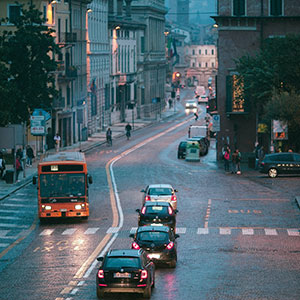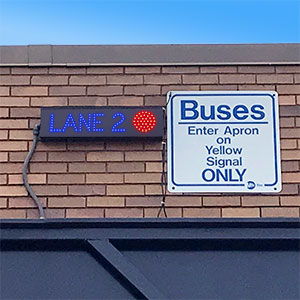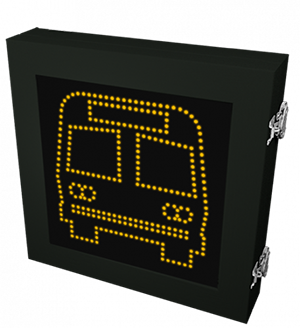- Products
- Accessories
- Stock Products
- Industry
- Information Center
- Login/Register
- Contact Us
Apr 21, 2022

Buses, and other forms of public transportation, help reduce traffic congestion and air pollution by being more space- and fuel-efficient. Having a bus lane dedicated solely to bus service on certain days and times during peak traffic helps speed up public transportation times. They do this by allowing buses to move freely in traffic, making bus travel less susceptible to traffic congestion, faster, and more reliable. Let’s take a closer look at some of their key advantages.

Lanes dedicated to buses are exclusive to them, not for private vehicles. This lets buses avoid the congestion created by personal vehicles, helping increase their speed, punctuality, and reliability. But their congestion relieving capabilities and their speed, timeliness, and reliability are only as effective as the means to ensure they remain segregated. For instance, while less practical and more costly, a protective barrier for a bus lane is more effective at keeping private vehicles out of exclusive lanes than painted lines. When bus lane restrictions are followed, they boost transit capacity substantially. In fact, data from the National Association of City Transportation Officials (NACTO) shows that bus lanes can accommodate 10,000 to 25,000 people per hour. This dwarfs their findings of 600 to 1,600 people per hour in private vehicles. These figures clearly demonstrate that bus lanes are viable for reducing traffic congestion while bolstering transit capacity.
Investing in a dedicated lane for buses is a high return on investment (ROI), low price tag initiative to improve transportation infrastructure. Existing traffic lanes can be converted into bus-only lanes at the cost of implementing street markings and signage. For new construction, the lanes typically come at a price tag of less than $1 million per mile for a two-way dedicated bus lane. Compared with highways (around $2.6 million per lane mile) and subways (on average, more than $800 million per mile of underground track), implementing bus lanes is clearly a more cost-effective choice.
As noted, bus lanes inherently reduce traffic congestion, so with fewer cars on the road, by default, it equates to less pollution. This notion is amplified when public transportation infrastructure is appropriately invested in. When public transportation connects more people to their jobs, schools, public services, and entertainment, they are more likely to take advantage of it. As a result, they will more frequently put aside their personal, gas-powered vehicles, further lowering tailpipe emissions. Part of that investment is dedicated bus lanes that make buses a reliable, easily accessible, and fast way for riders to get to their destinations.
Buses are also fuel-efficient, in terms of fuel consumed per rider, compared to single-occupancy vehicles. A full-sized bus with just seven total passengers has a better fuel economy (measured in Person-Miles per Gallon – PMGP) than the average car. When fully occupied, buses have a max PMPG of 330, dwarfing the max PMGP, 113, of cars.

To achieve these benefits, these lanes need to be clearly marked and highly visible to motorists, pedestrians, and bus riders. In many urban areas, such as San Francisco, the bus lane is painted red, making it easier for motorists to identify the lane and less likely to get a citation for unintentionally driving in a transit lane.
Furthering the notions of high visibility and clear readability for a bus lane is signage. Dynamic, digital, and illuminated signage provides an excellent way to relay critical information about a bus lane to everyone on roadways so the bus lane can operate seamlessly. LED signs for a bus lane can:
LED signs for bus-only lanes pack a much more significant punch in terms of their ability to garner attention compared to non-illuminated signage and are readable in direct sunlight. They also have a long lifespan (50,000 to 100,000 hours), require virtually no maintenance, are durable and reliable, and are environmentally friendly.
Perhaps the most appealing aspects of LED signs for bus-only lanes are the various types of signs that can be used and how the signs are controlled.

These signs use LEDs configured into letters, numbers, and shapes to form a message, e.g., bus lane open/closed, buses only, a bus-shaped outline with a down arrow, etc. These signs are super bright, automatically dim in low-light conditions, and feature narrow or wide viewing LEDs, depending on the application.
These signs offer the same brightness and readability as direct view signs but are more customizable. For instance, custom colors, logos, images, and text can be displayed on the sign’s face, giving traffic authorities nearly endless possibilities to customize bus lane messaging.
Like a light switch, both direct view and backlit signs can be turned on/off or the messaging swapped using a control/toggle switch. These switches are constructed of stainless steel, are prewired for quick installation, and are equipped with red and green indicator lights. An end-user simply flips the switch to the required position for the sign to display the message or turn it off.
Implementing bus lanes and equipping them with illuminated signage is a cost-effective and environmentally friendly way to improve public transportation while simultaneously decreasing traffic congestion. Signal-Tech — the leading LED signage and systems solutions company for the transportation industry — is ready to provide traffic authorities with bus lane products and turnkey solutions to achieve these goals. Contact us to learn more!